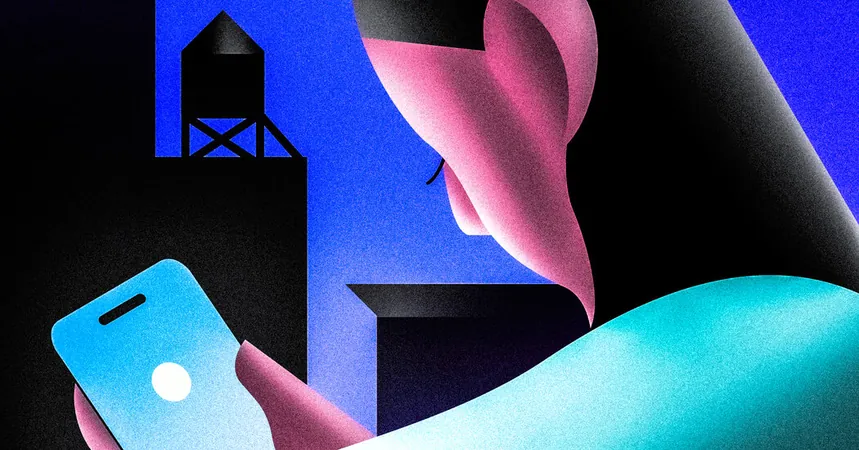
Unveiling the Disturbing Connection Between Technology and Loneliness
2024-11-10
Author: Wai
Introduction
As we delve deeper into the digital age, a disturbing trend has emerged: technology appears to be both a companion and a catalyst for loneliness, especially among teenagers. A revealing study conducted by Laura Marciano, a researcher at Harvard University, sheds light on this intricate relationship. Over the summer, Marciano surveyed 500 teenagers, garnering startling insights into their social interactions amid a backdrop of social media proliferation.
Technology and Social Disconnect
Despite being on summer break and immersed in digital platforms, over half of the participants reported not engaging in any conversation—either in person or online—in the last hour. This contradicts the assumption that social media engagements equate to real social connections. Instead of fostering relationships, these digital platforms may be ironically contributing to a growing sense of isolation among youth.
Rising Loneliness Epidemic
Recent statistics show that Americans, including a staggering one in two adults, are experiencing heightened feelings of loneliness compared to two decades ago. This loneliness has been deemed an “epidemic” by U.S. Surgeon General Dr. Vivek Murthy, prompting researchers and psychologists to investigate technology's role in this alarming phenomenon.
Shifting Communication Norms
One significant observation has been how communication norms have shifted dramatically since the advent of smartphones and social media. Traditional conversations over the phone have been largely replaced by text messages, which often lack emotional nuance and authenticity. This shift can lead to a disconnect that exacerbates feelings of loneliness, especially among teenagers, who primarily communicate via text.
Social Media Use and Loneliness
In an eye-opening review aggregating data from 30 studies on tech use during the pandemic, Marciano and her colleagues found a clear correlation between social media use and loneliness. Many young users felt compelled to present curated versions of their lives, often falling into the trap of social comparison—a psychological process where individuals measure themselves against others. Notably, feelings of inadequacy often stemmed from seeing friends’ highlight reels on social media, intensifying feelings of isolation.
The Dual Nature of Social Comparisons
Chia-chen Yang, an educational psychology professor, emphasizes that not all social comparisons are detrimental. While some can inspire motivation, the judgmental comparisons that stir envy can lead to feelings of alienation. For instance, a 2018 study led by Yang revealed that freshmen students experienced emotional distress from unfavorable comparisons on platforms like Instagram and Facebook.
Positive Aspects of Social Media
It's important to note that social media can also have a positive impact when users engage meaningfully, as seen when a friend's achievements inspire others. Still, the predominant design of these platforms encourages users to seek validation through likes and shares, pushing them into cycles of envy and FOMO (fear of missing out).
Steps Towards Healthier Digital Habits
Recognizing the need for healthier digital habits, some platforms like Instagram have begun offering features that enable users to hide like counts to mitigate the comparative anxiety. But experts like Dr. Murthy and Dr. Yang advocate for more profound self-reflection and interpersonal connections beyond text messages.
Enhancing Authentic Connections
Personal connections, especially through voice and video calls, have shown to yield the most positive mental health outcomes. Yet, only about 2% of teens reported using video calls, indicating a troubling trend where authentic connections are sacrificed for quick, impersonal exchanges.
Changing Communication Cultures
The culture of “HBD” text messages has replaced the personal touch of a birthday call, demonstrating how communication styles have evolved—and not always for the better. Dr. Murthy stresses the immense benefits of genuine interactions, affirming that even brief moments spent seeing someone's face and hearing their voice can significantly enhance feelings of connection.
Binge-Watching and Mental Health
Moreover, binge-watching habits have also come under scrutiny. Recent studies indicate a connection between excessive screen time dedicated to streaming and rising levels of anxiety and depression among adults. This trend not only harms mental health but can detract from social relationships, as individuals replace human interaction with passive consumption of content.
AI Tools and Social Isolation
Adding to this unsettling picture, the rise of artificial intelligence tools has led some teens to express loneliness due to feelings of judgment from peers. These tools, described as more accepting than human interactions, highlight a potential future where technology could inadvertently replace authentic social connections.
Conclusion
As students navigate increasingly quiet campus environments dominated by screens, Dr. Murthy highlights a crucial question: How can individuals maintain connections when everyone is preoccupied with their devices? This dilemma underscores the need for awareness around our technology habits and the profound impact they may have on our mental and emotional well-being.
The findings of this research serve as a clarion call for individuals, particularly the younger generation, to reassess their digital interactions and strive for deeper, more meaningful connections in a world heavily influenced by technology.



 Brasil (PT)
Brasil (PT)
 Canada (EN)
Canada (EN)
 Chile (ES)
Chile (ES)
 España (ES)
España (ES)
 France (FR)
France (FR)
 Hong Kong (EN)
Hong Kong (EN)
 Italia (IT)
Italia (IT)
 日本 (JA)
日本 (JA)
 Magyarország (HU)
Magyarország (HU)
 Norge (NO)
Norge (NO)
 Polska (PL)
Polska (PL)
 Schweiz (DE)
Schweiz (DE)
 Singapore (EN)
Singapore (EN)
 Sverige (SV)
Sverige (SV)
 Suomi (FI)
Suomi (FI)
 Türkiye (TR)
Türkiye (TR)